University Financial Budget Management Questionnaire and Case Study
VerifiedAdded on 2023/03/31
|19
|3265
|362
Homework Assignment
AI Summary
This assignment, focusing on financial budget management, is divided into two parts: a questionnaire and a case study. The questionnaire explores various aspects of budgeting, including the finance manager's role in budget communication, monitoring and control activities, sales variance reports, fixed and variable costs, vertical analysis, inventory turnover, budget information communication, controllable and uncontrollable costs, risk management, contingency plans, the responsibilities of budget holders, and the Corporations Act. The case study delves into accounting principles, government legislation, and their implications in financial contexts. The assignment aims to provide a comprehensive understanding of financial planning, budgeting, and control within a business setting.
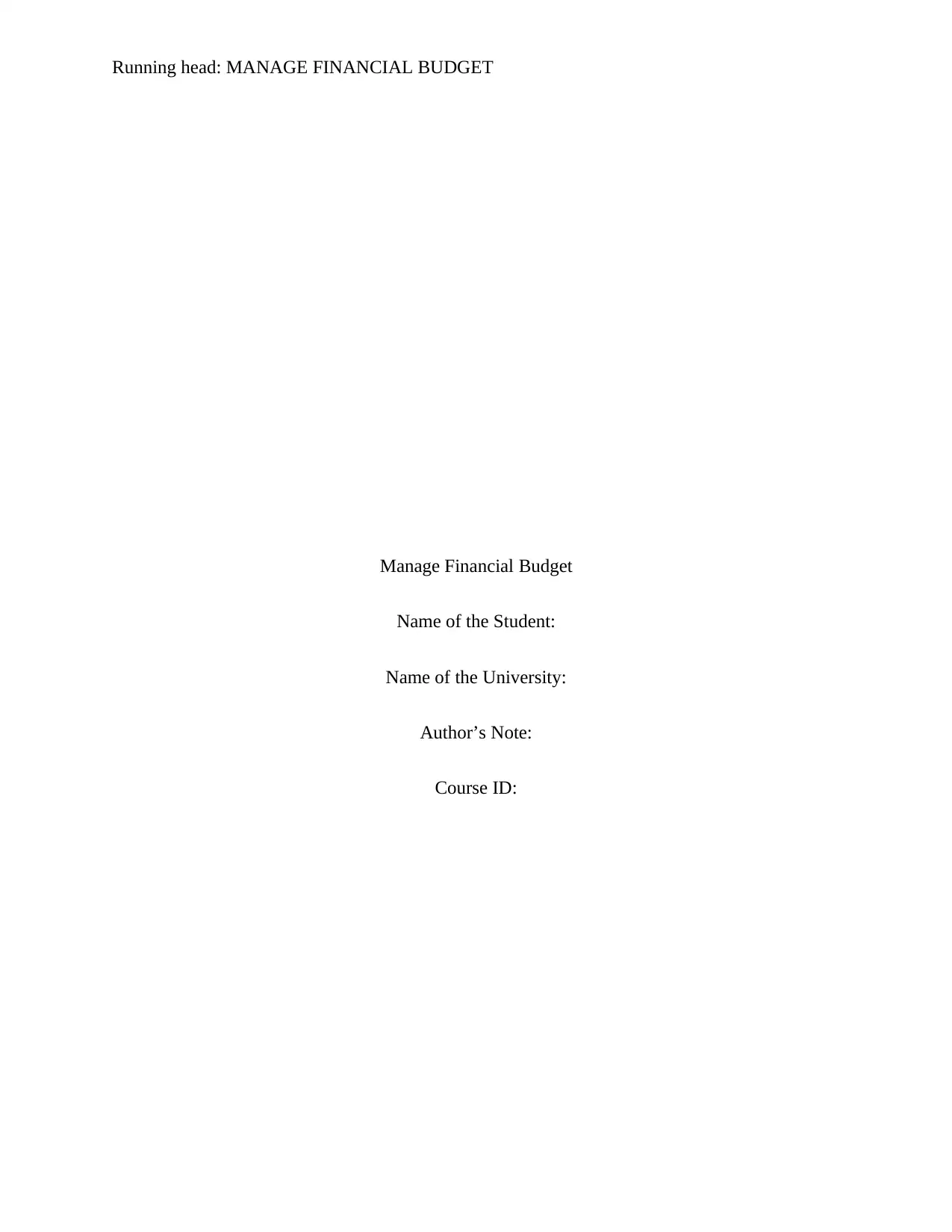
Running head: MANAGE FINANCIAL BUDGET
Manage Financial Budget
Name of the Student:
Name of the University:
Author’s Note:
Course ID:
Manage Financial Budget
Name of the Student:
Name of the University:
Author’s Note:
Course ID:
Paraphrase This Document
Need a fresh take? Get an instant paraphrase of this document with our AI Paraphraser
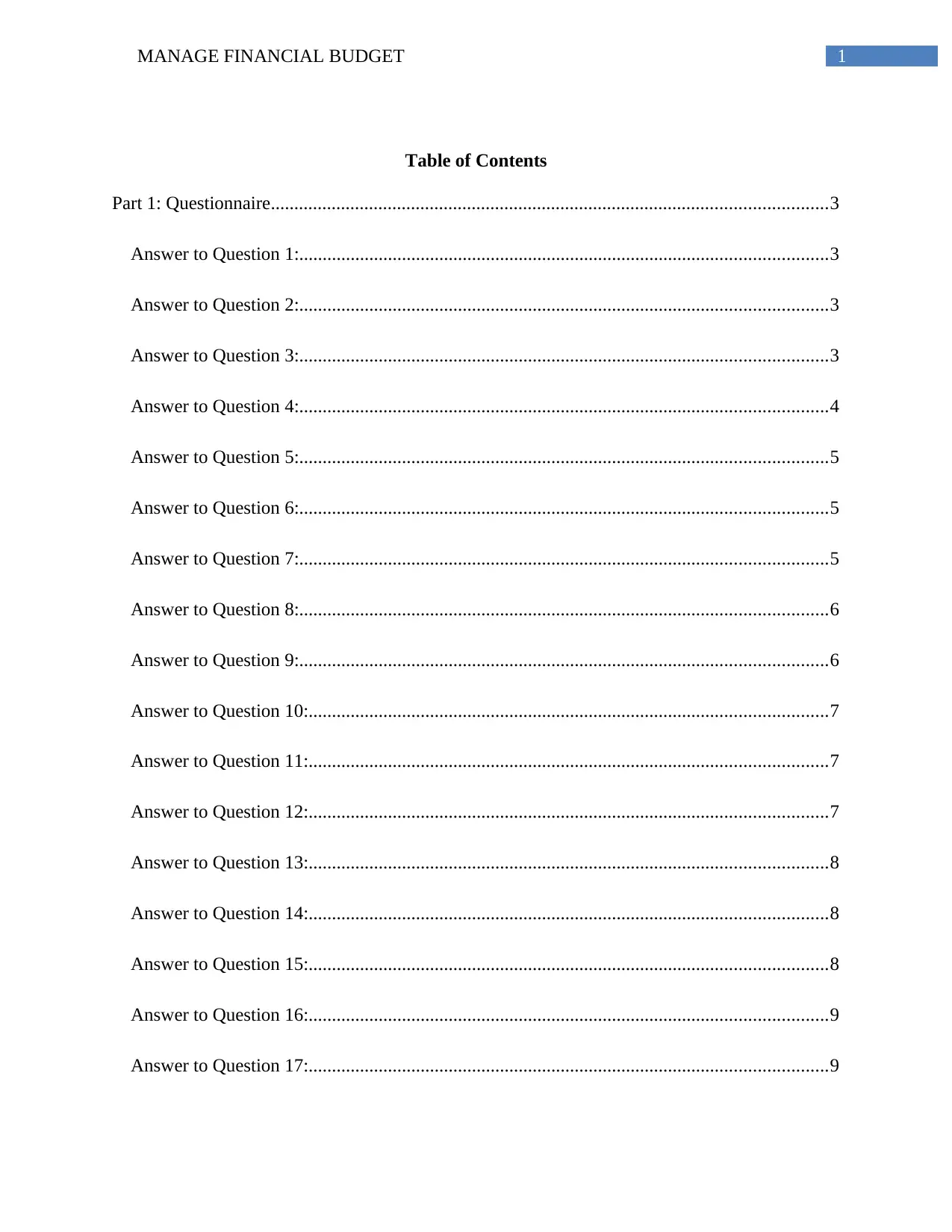
1MANAGE FINANCIAL BUDGET
Table of Contents
Part 1: Questionnaire.......................................................................................................................3
Answer to Question 1:.................................................................................................................3
Answer to Question 2:.................................................................................................................3
Answer to Question 3:.................................................................................................................3
Answer to Question 4:.................................................................................................................4
Answer to Question 5:.................................................................................................................5
Answer to Question 6:.................................................................................................................5
Answer to Question 7:.................................................................................................................5
Answer to Question 8:.................................................................................................................6
Answer to Question 9:.................................................................................................................6
Answer to Question 10:...............................................................................................................7
Answer to Question 11:...............................................................................................................7
Answer to Question 12:...............................................................................................................7
Answer to Question 13:...............................................................................................................8
Answer to Question 14:...............................................................................................................8
Answer to Question 15:...............................................................................................................8
Answer to Question 16:...............................................................................................................9
Answer to Question 17:...............................................................................................................9
Table of Contents
Part 1: Questionnaire.......................................................................................................................3
Answer to Question 1:.................................................................................................................3
Answer to Question 2:.................................................................................................................3
Answer to Question 3:.................................................................................................................3
Answer to Question 4:.................................................................................................................4
Answer to Question 5:.................................................................................................................5
Answer to Question 6:.................................................................................................................5
Answer to Question 7:.................................................................................................................5
Answer to Question 8:.................................................................................................................6
Answer to Question 9:.................................................................................................................6
Answer to Question 10:...............................................................................................................7
Answer to Question 11:...............................................................................................................7
Answer to Question 12:...............................................................................................................7
Answer to Question 13:...............................................................................................................8
Answer to Question 14:...............................................................................................................8
Answer to Question 15:...............................................................................................................8
Answer to Question 16:...............................................................................................................9
Answer to Question 17:...............................................................................................................9
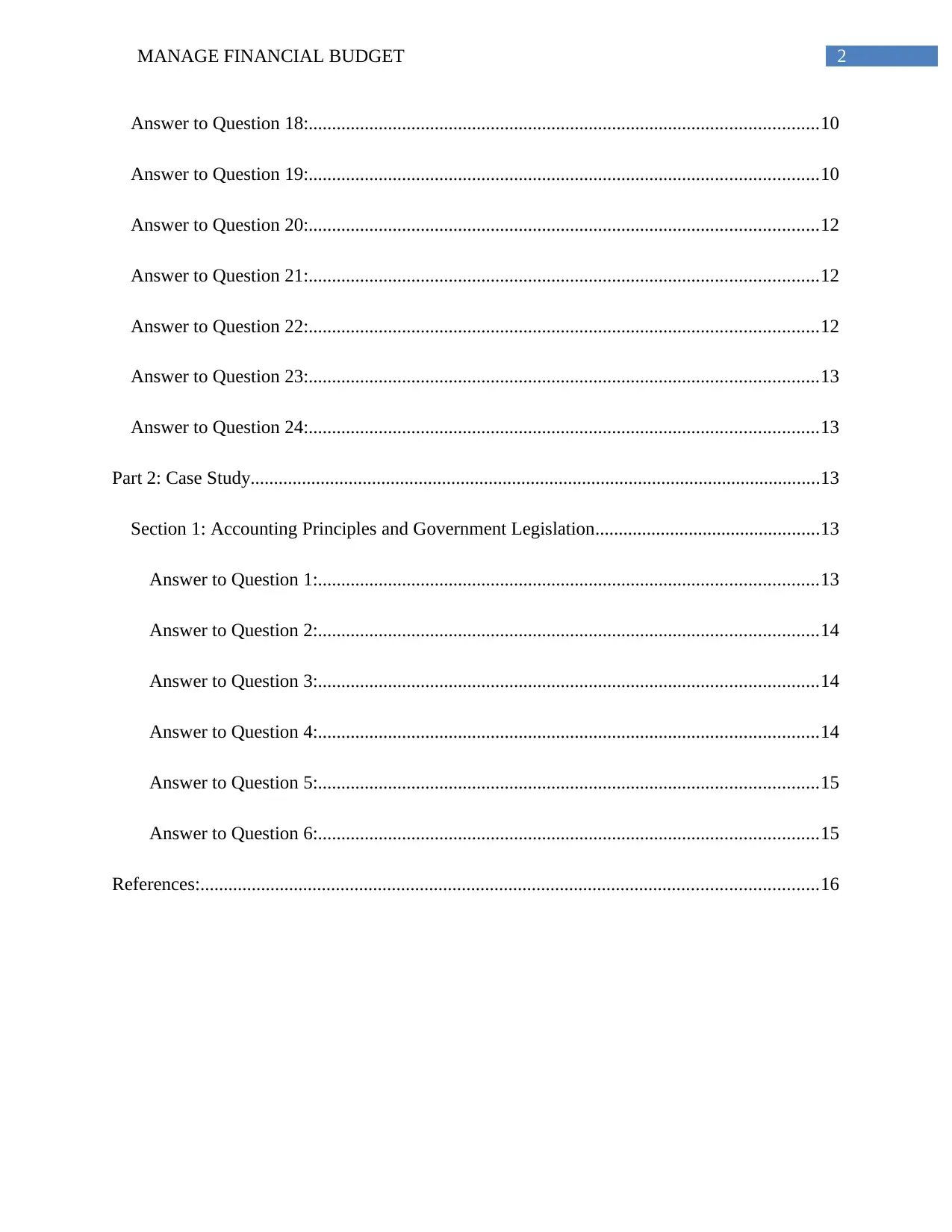
2MANAGE FINANCIAL BUDGET
Answer to Question 18:.............................................................................................................10
Answer to Question 19:.............................................................................................................10
Answer to Question 20:.............................................................................................................12
Answer to Question 21:.............................................................................................................12
Answer to Question 22:.............................................................................................................12
Answer to Question 23:.............................................................................................................13
Answer to Question 24:.............................................................................................................13
Part 2: Case Study..........................................................................................................................13
Section 1: Accounting Principles and Government Legislation................................................13
Answer to Question 1:...........................................................................................................13
Answer to Question 2:...........................................................................................................14
Answer to Question 3:...........................................................................................................14
Answer to Question 4:...........................................................................................................14
Answer to Question 5:...........................................................................................................15
Answer to Question 6:...........................................................................................................15
References:....................................................................................................................................16
Answer to Question 18:.............................................................................................................10
Answer to Question 19:.............................................................................................................10
Answer to Question 20:.............................................................................................................12
Answer to Question 21:.............................................................................................................12
Answer to Question 22:.............................................................................................................12
Answer to Question 23:.............................................................................................................13
Answer to Question 24:.............................................................................................................13
Part 2: Case Study..........................................................................................................................13
Section 1: Accounting Principles and Government Legislation................................................13
Answer to Question 1:...........................................................................................................13
Answer to Question 2:...........................................................................................................14
Answer to Question 3:...........................................................................................................14
Answer to Question 4:...........................................................................................................14
Answer to Question 5:...........................................................................................................15
Answer to Question 6:...........................................................................................................15
References:....................................................................................................................................16
⊘ This is a preview!⊘
Do you want full access?
Subscribe today to unlock all pages.

Trusted by 1+ million students worldwide
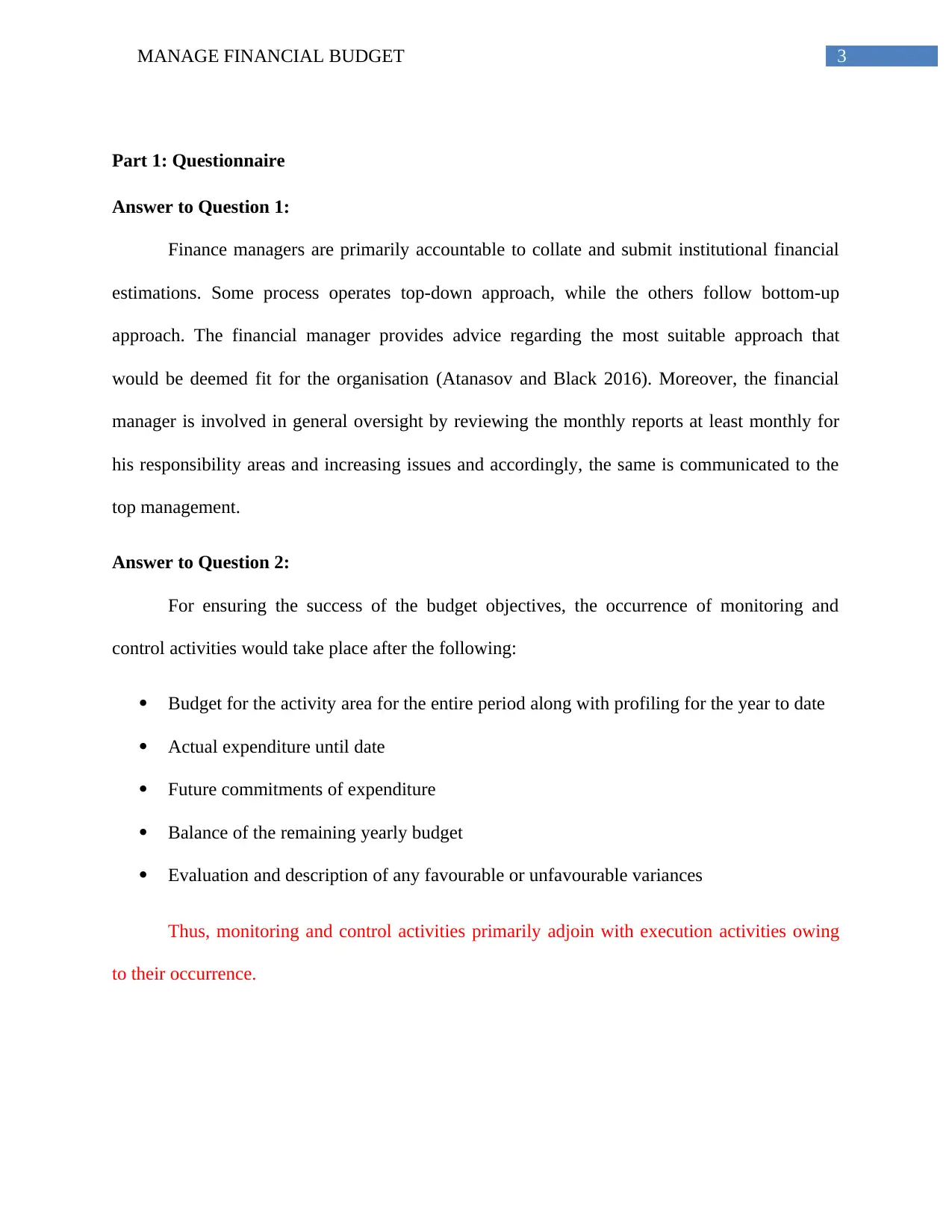
3MANAGE FINANCIAL BUDGET
Part 1: Questionnaire
Answer to Question 1:
Finance managers are primarily accountable to collate and submit institutional financial
estimations. Some process operates top-down approach, while the others follow bottom-up
approach. The financial manager provides advice regarding the most suitable approach that
would be deemed fit for the organisation (Atanasov and Black 2016). Moreover, the financial
manager is involved in general oversight by reviewing the monthly reports at least monthly for
his responsibility areas and increasing issues and accordingly, the same is communicated to the
top management.
Answer to Question 2:
For ensuring the success of the budget objectives, the occurrence of monitoring and
control activities would take place after the following:
Budget for the activity area for the entire period along with profiling for the year to date
Actual expenditure until date
Future commitments of expenditure
Balance of the remaining yearly budget
Evaluation and description of any favourable or unfavourable variances
Thus, monitoring and control activities primarily adjoin with execution activities owing
to their occurrence.
Part 1: Questionnaire
Answer to Question 1:
Finance managers are primarily accountable to collate and submit institutional financial
estimations. Some process operates top-down approach, while the others follow bottom-up
approach. The financial manager provides advice regarding the most suitable approach that
would be deemed fit for the organisation (Atanasov and Black 2016). Moreover, the financial
manager is involved in general oversight by reviewing the monthly reports at least monthly for
his responsibility areas and increasing issues and accordingly, the same is communicated to the
top management.
Answer to Question 2:
For ensuring the success of the budget objectives, the occurrence of monitoring and
control activities would take place after the following:
Budget for the activity area for the entire period along with profiling for the year to date
Actual expenditure until date
Future commitments of expenditure
Balance of the remaining yearly budget
Evaluation and description of any favourable or unfavourable variances
Thus, monitoring and control activities primarily adjoin with execution activities owing
to their occurrence.
Paraphrase This Document
Need a fresh take? Get an instant paraphrase of this document with our AI Paraphraser
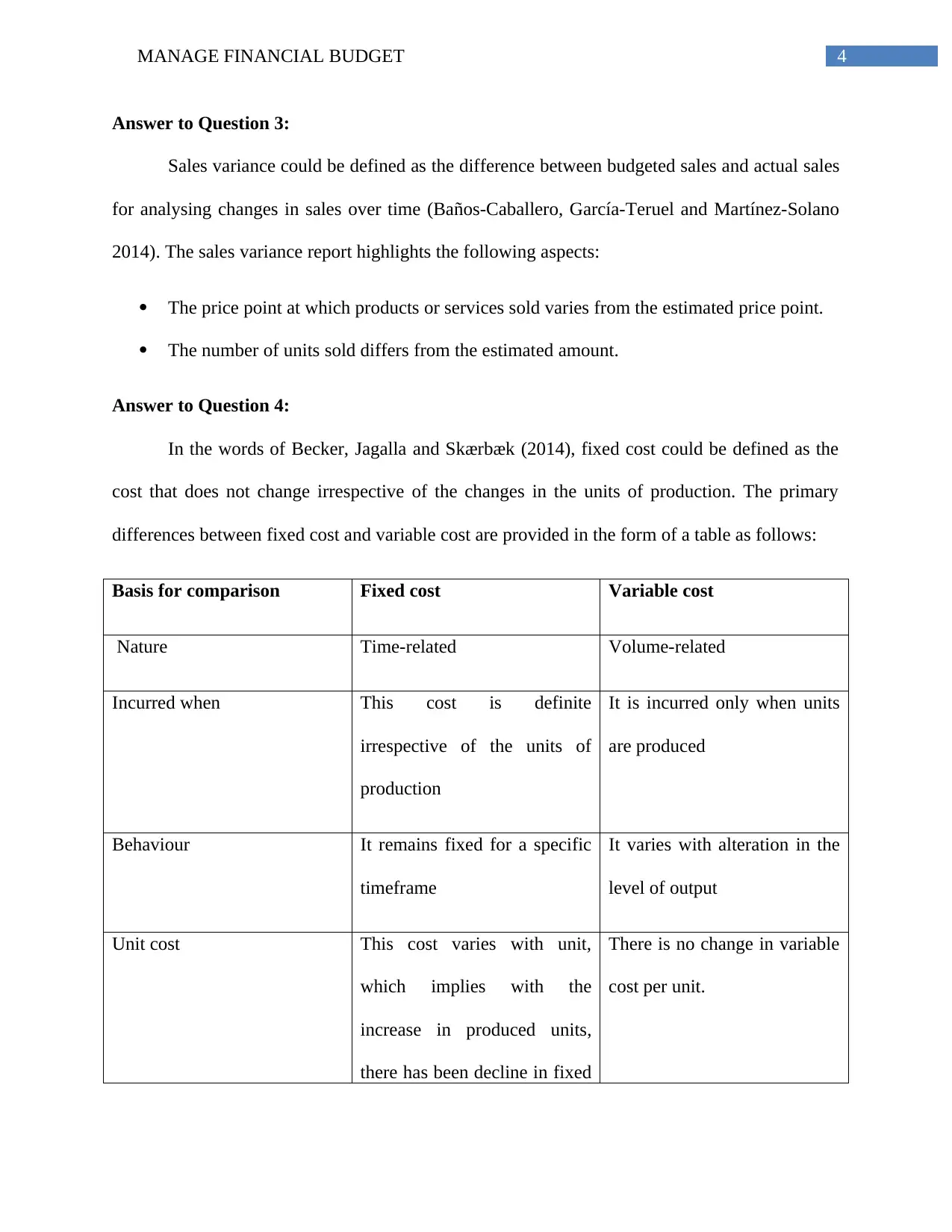
4MANAGE FINANCIAL BUDGET
Answer to Question 3:
Sales variance could be defined as the difference between budgeted sales and actual sales
for analysing changes in sales over time (Baños-Caballero, García-Teruel and Martínez-Solano
2014). The sales variance report highlights the following aspects:
The price point at which products or services sold varies from the estimated price point.
The number of units sold differs from the estimated amount.
Answer to Question 4:
In the words of Becker, Jagalla and Skærbæk (2014), fixed cost could be defined as the
cost that does not change irrespective of the changes in the units of production. The primary
differences between fixed cost and variable cost are provided in the form of a table as follows:
Basis for comparison Fixed cost Variable cost
Nature Time-related Volume-related
Incurred when This cost is definite
irrespective of the units of
production
It is incurred only when units
are produced
Behaviour It remains fixed for a specific
timeframe
It varies with alteration in the
level of output
Unit cost This cost varies with unit,
which implies with the
increase in produced units,
there has been decline in fixed
There is no change in variable
cost per unit.
Answer to Question 3:
Sales variance could be defined as the difference between budgeted sales and actual sales
for analysing changes in sales over time (Baños-Caballero, García-Teruel and Martínez-Solano
2014). The sales variance report highlights the following aspects:
The price point at which products or services sold varies from the estimated price point.
The number of units sold differs from the estimated amount.
Answer to Question 4:
In the words of Becker, Jagalla and Skærbæk (2014), fixed cost could be defined as the
cost that does not change irrespective of the changes in the units of production. The primary
differences between fixed cost and variable cost are provided in the form of a table as follows:
Basis for comparison Fixed cost Variable cost
Nature Time-related Volume-related
Incurred when This cost is definite
irrespective of the units of
production
It is incurred only when units
are produced
Behaviour It remains fixed for a specific
timeframe
It varies with alteration in the
level of output
Unit cost This cost varies with unit,
which implies with the
increase in produced units,
there has been decline in fixed
There is no change in variable
cost per unit.
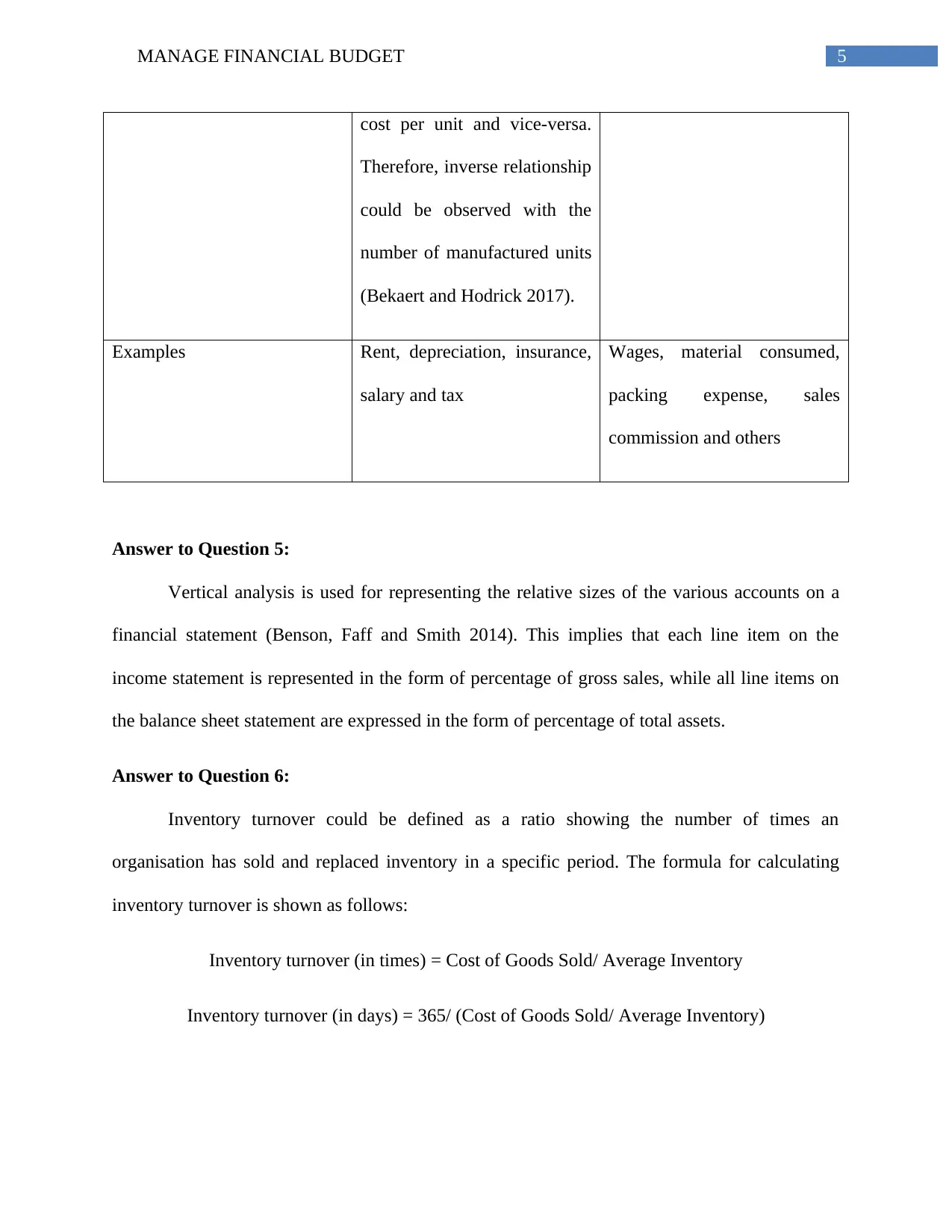
5MANAGE FINANCIAL BUDGET
cost per unit and vice-versa.
Therefore, inverse relationship
could be observed with the
number of manufactured units
(Bekaert and Hodrick 2017).
Examples Rent, depreciation, insurance,
salary and tax
Wages, material consumed,
packing expense, sales
commission and others
Answer to Question 5:
Vertical analysis is used for representing the relative sizes of the various accounts on a
financial statement (Benson, Faff and Smith 2014). This implies that each line item on the
income statement is represented in the form of percentage of gross sales, while all line items on
the balance sheet statement are expressed in the form of percentage of total assets.
Answer to Question 6:
Inventory turnover could be defined as a ratio showing the number of times an
organisation has sold and replaced inventory in a specific period. The formula for calculating
inventory turnover is shown as follows:
Inventory turnover (in times) = Cost of Goods Sold/ Average Inventory
Inventory turnover (in days) = 365/ (Cost of Goods Sold/ Average Inventory)
cost per unit and vice-versa.
Therefore, inverse relationship
could be observed with the
number of manufactured units
(Bekaert and Hodrick 2017).
Examples Rent, depreciation, insurance,
salary and tax
Wages, material consumed,
packing expense, sales
commission and others
Answer to Question 5:
Vertical analysis is used for representing the relative sizes of the various accounts on a
financial statement (Benson, Faff and Smith 2014). This implies that each line item on the
income statement is represented in the form of percentage of gross sales, while all line items on
the balance sheet statement are expressed in the form of percentage of total assets.
Answer to Question 6:
Inventory turnover could be defined as a ratio showing the number of times an
organisation has sold and replaced inventory in a specific period. The formula for calculating
inventory turnover is shown as follows:
Inventory turnover (in times) = Cost of Goods Sold/ Average Inventory
Inventory turnover (in days) = 365/ (Cost of Goods Sold/ Average Inventory)
⊘ This is a preview!⊘
Do you want full access?
Subscribe today to unlock all pages.

Trusted by 1+ million students worldwide
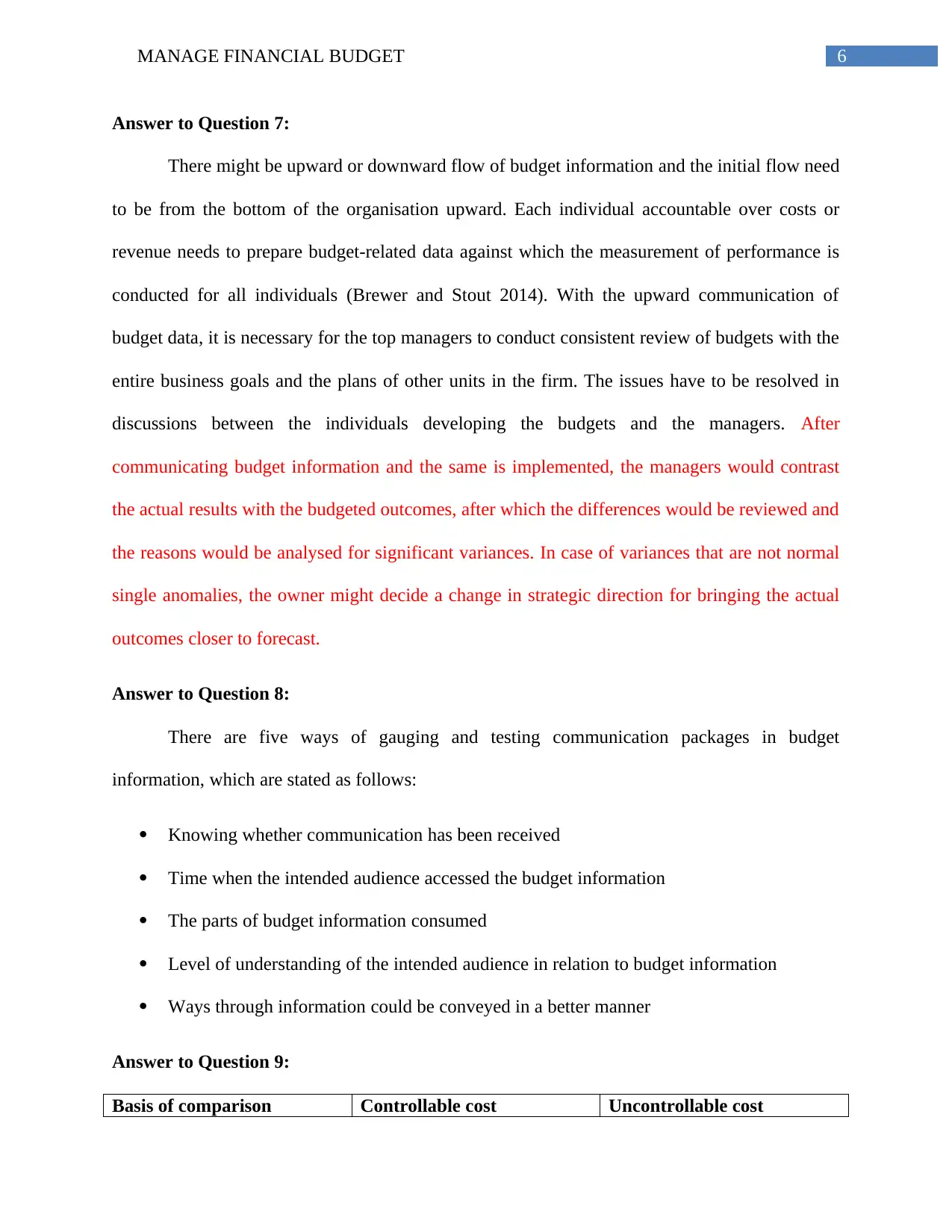
6MANAGE FINANCIAL BUDGET
Answer to Question 7:
There might be upward or downward flow of budget information and the initial flow need
to be from the bottom of the organisation upward. Each individual accountable over costs or
revenue needs to prepare budget-related data against which the measurement of performance is
conducted for all individuals (Brewer and Stout 2014). With the upward communication of
budget data, it is necessary for the top managers to conduct consistent review of budgets with the
entire business goals and the plans of other units in the firm. The issues have to be resolved in
discussions between the individuals developing the budgets and the managers. After
communicating budget information and the same is implemented, the managers would contrast
the actual results with the budgeted outcomes, after which the differences would be reviewed and
the reasons would be analysed for significant variances. In case of variances that are not normal
single anomalies, the owner might decide a change in strategic direction for bringing the actual
outcomes closer to forecast.
Answer to Question 8:
There are five ways of gauging and testing communication packages in budget
information, which are stated as follows:
Knowing whether communication has been received
Time when the intended audience accessed the budget information
The parts of budget information consumed
Level of understanding of the intended audience in relation to budget information
Ways through information could be conveyed in a better manner
Answer to Question 9:
Basis of comparison Controllable cost Uncontrollable cost
Answer to Question 7:
There might be upward or downward flow of budget information and the initial flow need
to be from the bottom of the organisation upward. Each individual accountable over costs or
revenue needs to prepare budget-related data against which the measurement of performance is
conducted for all individuals (Brewer and Stout 2014). With the upward communication of
budget data, it is necessary for the top managers to conduct consistent review of budgets with the
entire business goals and the plans of other units in the firm. The issues have to be resolved in
discussions between the individuals developing the budgets and the managers. After
communicating budget information and the same is implemented, the managers would contrast
the actual results with the budgeted outcomes, after which the differences would be reviewed and
the reasons would be analysed for significant variances. In case of variances that are not normal
single anomalies, the owner might decide a change in strategic direction for bringing the actual
outcomes closer to forecast.
Answer to Question 8:
There are five ways of gauging and testing communication packages in budget
information, which are stated as follows:
Knowing whether communication has been received
Time when the intended audience accessed the budget information
The parts of budget information consumed
Level of understanding of the intended audience in relation to budget information
Ways through information could be conveyed in a better manner
Answer to Question 9:
Basis of comparison Controllable cost Uncontrollable cost
Paraphrase This Document
Need a fresh take? Get an instant paraphrase of this document with our AI Paraphraser
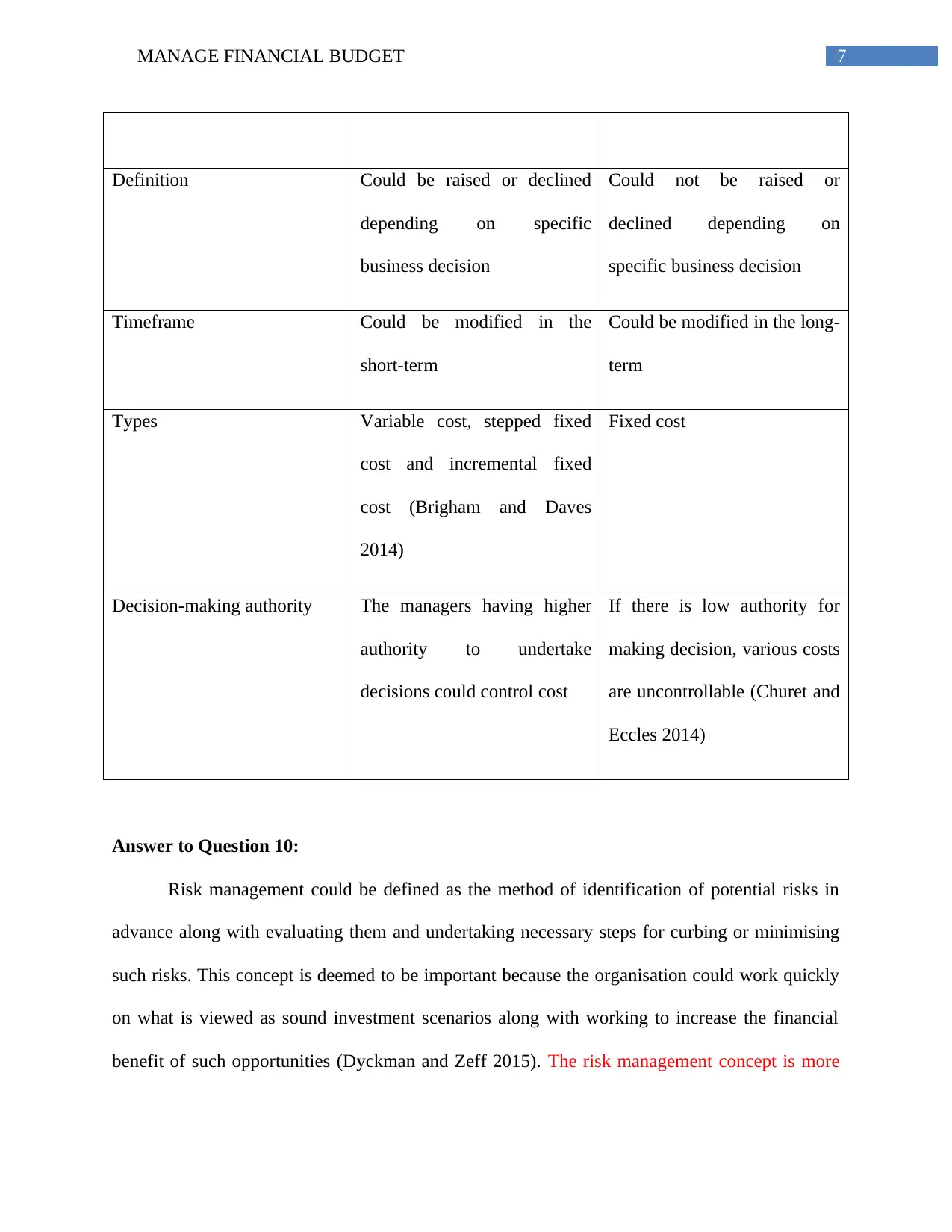
7MANAGE FINANCIAL BUDGET
Definition Could be raised or declined
depending on specific
business decision
Could not be raised or
declined depending on
specific business decision
Timeframe Could be modified in the
short-term
Could be modified in the long-
term
Types Variable cost, stepped fixed
cost and incremental fixed
cost (Brigham and Daves
2014)
Fixed cost
Decision-making authority The managers having higher
authority to undertake
decisions could control cost
If there is low authority for
making decision, various costs
are uncontrollable (Churet and
Eccles 2014)
Answer to Question 10:
Risk management could be defined as the method of identification of potential risks in
advance along with evaluating them and undertaking necessary steps for curbing or minimising
such risks. This concept is deemed to be important because the organisation could work quickly
on what is viewed as sound investment scenarios along with working to increase the financial
benefit of such opportunities (Dyckman and Zeff 2015). The risk management concept is more
Definition Could be raised or declined
depending on specific
business decision
Could not be raised or
declined depending on
specific business decision
Timeframe Could be modified in the
short-term
Could be modified in the long-
term
Types Variable cost, stepped fixed
cost and incremental fixed
cost (Brigham and Daves
2014)
Fixed cost
Decision-making authority The managers having higher
authority to undertake
decisions could control cost
If there is low authority for
making decision, various costs
are uncontrollable (Churet and
Eccles 2014)
Answer to Question 10:
Risk management could be defined as the method of identification of potential risks in
advance along with evaluating them and undertaking necessary steps for curbing or minimising
such risks. This concept is deemed to be important because the organisation could work quickly
on what is viewed as sound investment scenarios along with working to increase the financial
benefit of such opportunities (Dyckman and Zeff 2015). The risk management concept is more
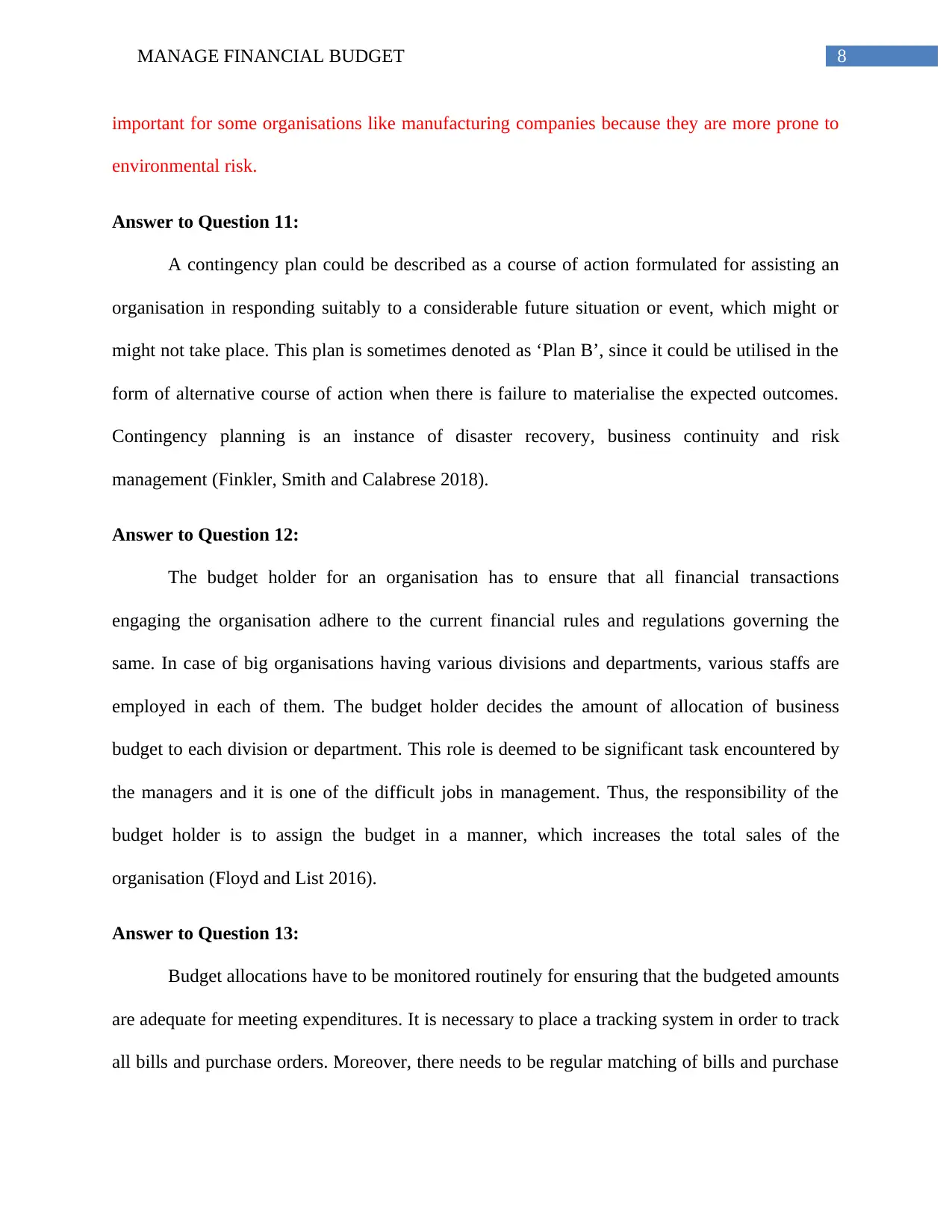
8MANAGE FINANCIAL BUDGET
important for some organisations like manufacturing companies because they are more prone to
environmental risk.
Answer to Question 11:
A contingency plan could be described as a course of action formulated for assisting an
organisation in responding suitably to a considerable future situation or event, which might or
might not take place. This plan is sometimes denoted as ‘Plan B’, since it could be utilised in the
form of alternative course of action when there is failure to materialise the expected outcomes.
Contingency planning is an instance of disaster recovery, business continuity and risk
management (Finkler, Smith and Calabrese 2018).
Answer to Question 12:
The budget holder for an organisation has to ensure that all financial transactions
engaging the organisation adhere to the current financial rules and regulations governing the
same. In case of big organisations having various divisions and departments, various staffs are
employed in each of them. The budget holder decides the amount of allocation of business
budget to each division or department. This role is deemed to be significant task encountered by
the managers and it is one of the difficult jobs in management. Thus, the responsibility of the
budget holder is to assign the budget in a manner, which increases the total sales of the
organisation (Floyd and List 2016).
Answer to Question 13:
Budget allocations have to be monitored routinely for ensuring that the budgeted amounts
are adequate for meeting expenditures. It is necessary to place a tracking system in order to track
all bills and purchase orders. Moreover, there needs to be regular matching of bills and purchase
important for some organisations like manufacturing companies because they are more prone to
environmental risk.
Answer to Question 11:
A contingency plan could be described as a course of action formulated for assisting an
organisation in responding suitably to a considerable future situation or event, which might or
might not take place. This plan is sometimes denoted as ‘Plan B’, since it could be utilised in the
form of alternative course of action when there is failure to materialise the expected outcomes.
Contingency planning is an instance of disaster recovery, business continuity and risk
management (Finkler, Smith and Calabrese 2018).
Answer to Question 12:
The budget holder for an organisation has to ensure that all financial transactions
engaging the organisation adhere to the current financial rules and regulations governing the
same. In case of big organisations having various divisions and departments, various staffs are
employed in each of them. The budget holder decides the amount of allocation of business
budget to each division or department. This role is deemed to be significant task encountered by
the managers and it is one of the difficult jobs in management. Thus, the responsibility of the
budget holder is to assign the budget in a manner, which increases the total sales of the
organisation (Floyd and List 2016).
Answer to Question 13:
Budget allocations have to be monitored routinely for ensuring that the budgeted amounts
are adequate for meeting expenditures. It is necessary to place a tracking system in order to track
all bills and purchase orders. Moreover, there needs to be regular matching of bills and purchase
⊘ This is a preview!⊘
Do you want full access?
Subscribe today to unlock all pages.

Trusted by 1+ million students worldwide
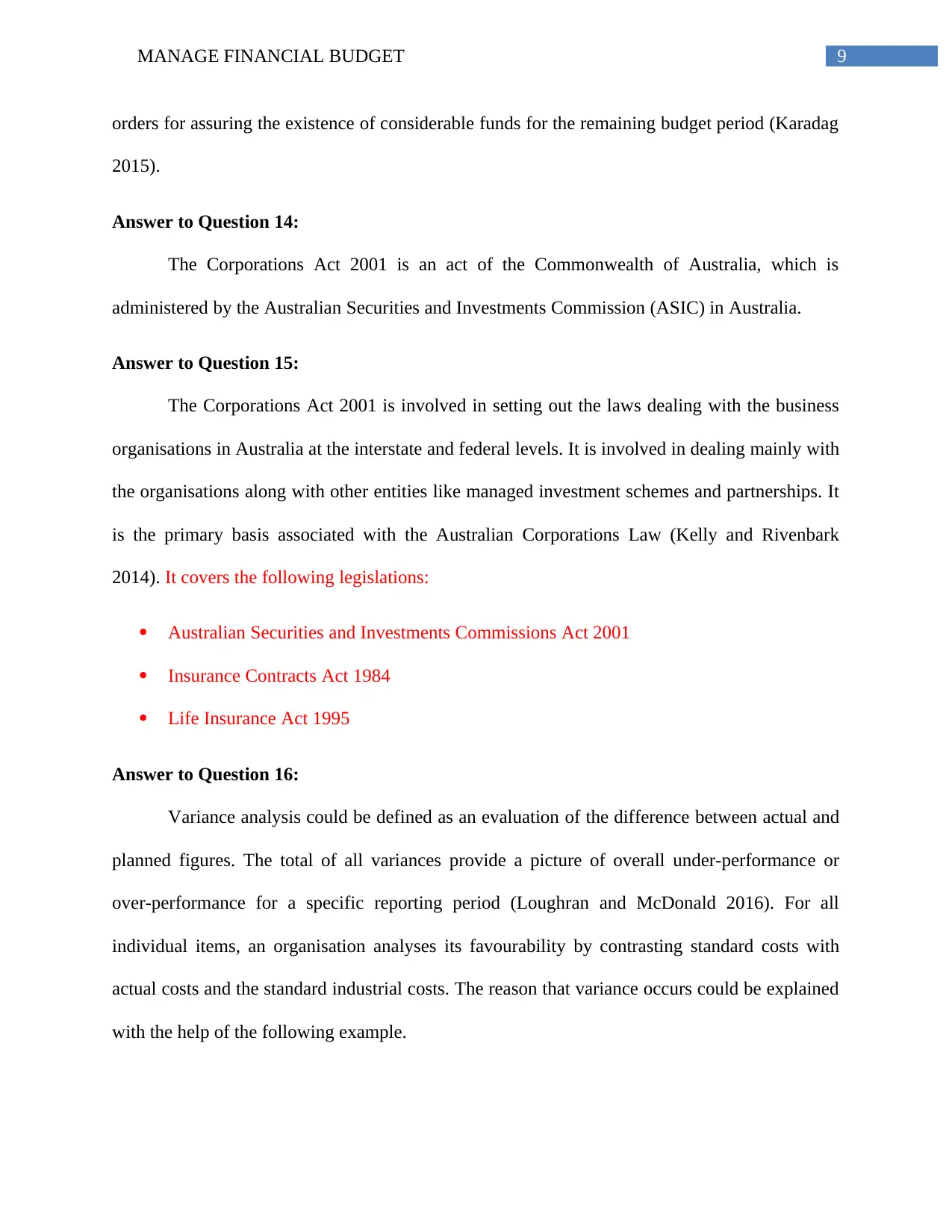
9MANAGE FINANCIAL BUDGET
orders for assuring the existence of considerable funds for the remaining budget period (Karadag
2015).
Answer to Question 14:
The Corporations Act 2001 is an act of the Commonwealth of Australia, which is
administered by the Australian Securities and Investments Commission (ASIC) in Australia.
Answer to Question 15:
The Corporations Act 2001 is involved in setting out the laws dealing with the business
organisations in Australia at the interstate and federal levels. It is involved in dealing mainly with
the organisations along with other entities like managed investment schemes and partnerships. It
is the primary basis associated with the Australian Corporations Law (Kelly and Rivenbark
2014). It covers the following legislations:
Australian Securities and Investments Commissions Act 2001
Insurance Contracts Act 1984
Life Insurance Act 1995
Answer to Question 16:
Variance analysis could be defined as an evaluation of the difference between actual and
planned figures. The total of all variances provide a picture of overall under-performance or
over-performance for a specific reporting period (Loughran and McDonald 2016). For all
individual items, an organisation analyses its favourability by contrasting standard costs with
actual costs and the standard industrial costs. The reason that variance occurs could be explained
with the help of the following example.
orders for assuring the existence of considerable funds for the remaining budget period (Karadag
2015).
Answer to Question 14:
The Corporations Act 2001 is an act of the Commonwealth of Australia, which is
administered by the Australian Securities and Investments Commission (ASIC) in Australia.
Answer to Question 15:
The Corporations Act 2001 is involved in setting out the laws dealing with the business
organisations in Australia at the interstate and federal levels. It is involved in dealing mainly with
the organisations along with other entities like managed investment schemes and partnerships. It
is the primary basis associated with the Australian Corporations Law (Kelly and Rivenbark
2014). It covers the following legislations:
Australian Securities and Investments Commissions Act 2001
Insurance Contracts Act 1984
Life Insurance Act 1995
Answer to Question 16:
Variance analysis could be defined as an evaluation of the difference between actual and
planned figures. The total of all variances provide a picture of overall under-performance or
over-performance for a specific reporting period (Loughran and McDonald 2016). For all
individual items, an organisation analyses its favourability by contrasting standard costs with
actual costs and the standard industrial costs. The reason that variance occurs could be explained
with the help of the following example.
Paraphrase This Document
Need a fresh take? Get an instant paraphrase of this document with our AI Paraphraser
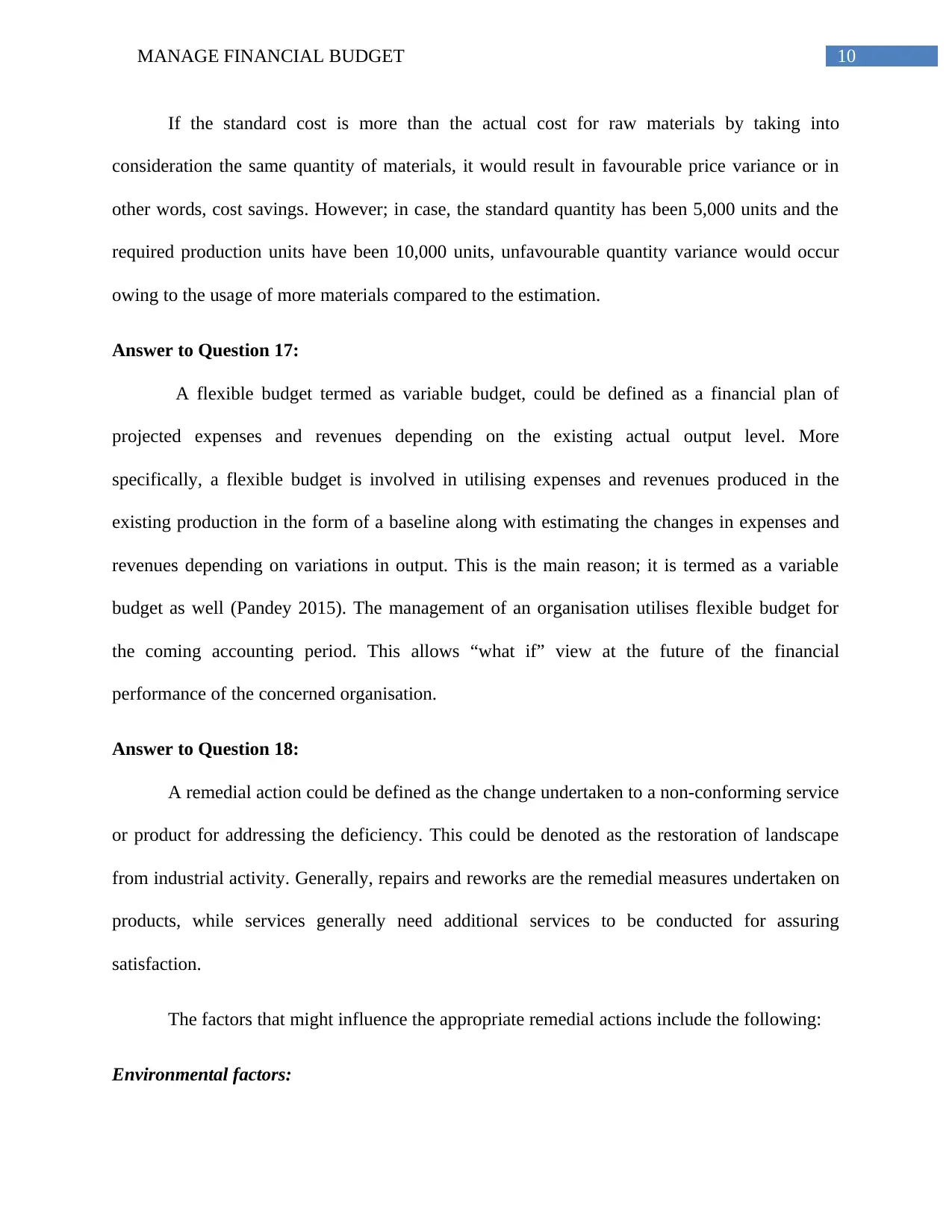
10MANAGE FINANCIAL BUDGET
If the standard cost is more than the actual cost for raw materials by taking into
consideration the same quantity of materials, it would result in favourable price variance or in
other words, cost savings. However; in case, the standard quantity has been 5,000 units and the
required production units have been 10,000 units, unfavourable quantity variance would occur
owing to the usage of more materials compared to the estimation.
Answer to Question 17:
A flexible budget termed as variable budget, could be defined as a financial plan of
projected expenses and revenues depending on the existing actual output level. More
specifically, a flexible budget is involved in utilising expenses and revenues produced in the
existing production in the form of a baseline along with estimating the changes in expenses and
revenues depending on variations in output. This is the main reason; it is termed as a variable
budget as well (Pandey 2015). The management of an organisation utilises flexible budget for
the coming accounting period. This allows “what if” view at the future of the financial
performance of the concerned organisation.
Answer to Question 18:
A remedial action could be defined as the change undertaken to a non-conforming service
or product for addressing the deficiency. This could be denoted as the restoration of landscape
from industrial activity. Generally, repairs and reworks are the remedial measures undertaken on
products, while services generally need additional services to be conducted for assuring
satisfaction.
The factors that might influence the appropriate remedial actions include the following:
Environmental factors:
If the standard cost is more than the actual cost for raw materials by taking into
consideration the same quantity of materials, it would result in favourable price variance or in
other words, cost savings. However; in case, the standard quantity has been 5,000 units and the
required production units have been 10,000 units, unfavourable quantity variance would occur
owing to the usage of more materials compared to the estimation.
Answer to Question 17:
A flexible budget termed as variable budget, could be defined as a financial plan of
projected expenses and revenues depending on the existing actual output level. More
specifically, a flexible budget is involved in utilising expenses and revenues produced in the
existing production in the form of a baseline along with estimating the changes in expenses and
revenues depending on variations in output. This is the main reason; it is termed as a variable
budget as well (Pandey 2015). The management of an organisation utilises flexible budget for
the coming accounting period. This allows “what if” view at the future of the financial
performance of the concerned organisation.
Answer to Question 18:
A remedial action could be defined as the change undertaken to a non-conforming service
or product for addressing the deficiency. This could be denoted as the restoration of landscape
from industrial activity. Generally, repairs and reworks are the remedial measures undertaken on
products, while services generally need additional services to be conducted for assuring
satisfaction.
The factors that might influence the appropriate remedial actions include the following:
Environmental factors:
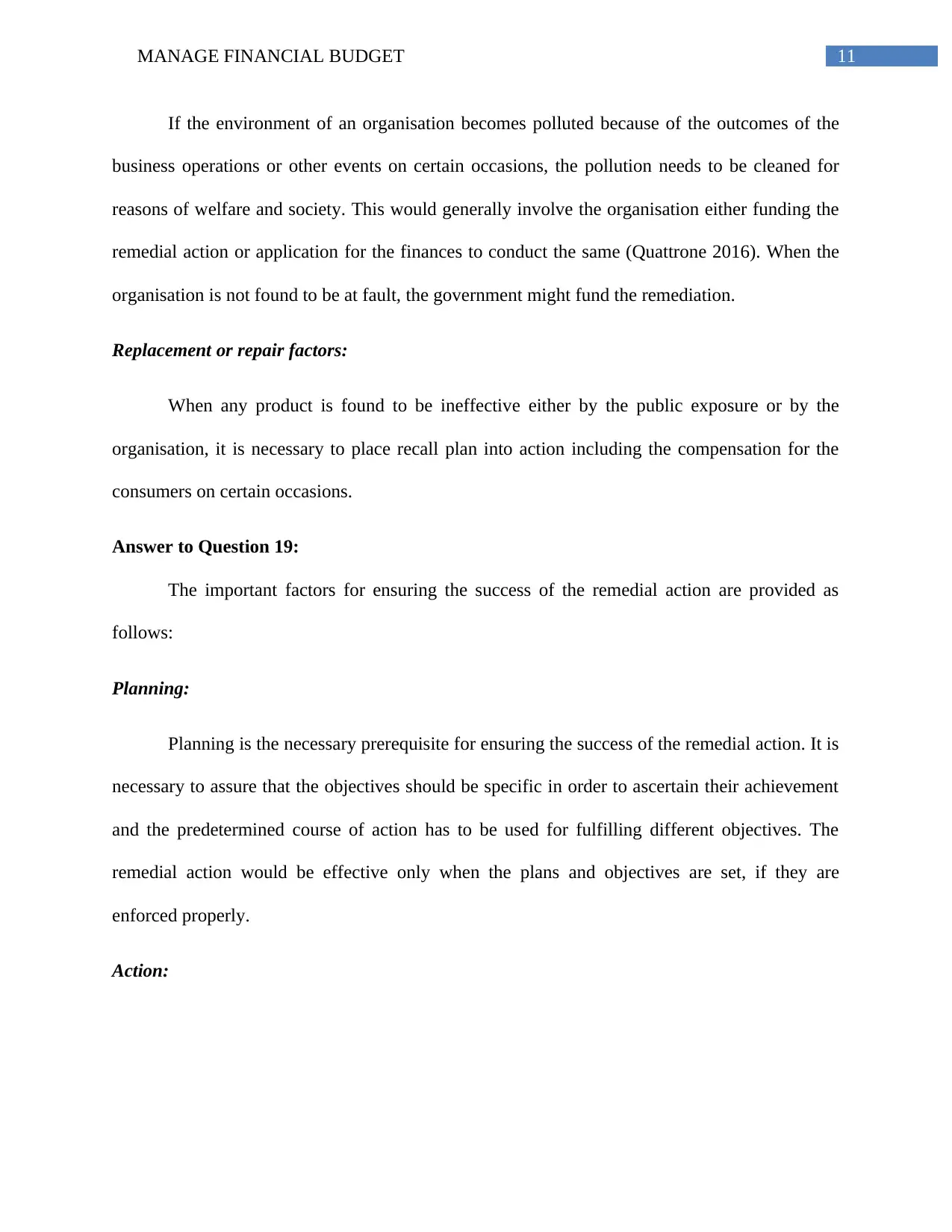
11MANAGE FINANCIAL BUDGET
If the environment of an organisation becomes polluted because of the outcomes of the
business operations or other events on certain occasions, the pollution needs to be cleaned for
reasons of welfare and society. This would generally involve the organisation either funding the
remedial action or application for the finances to conduct the same (Quattrone 2016). When the
organisation is not found to be at fault, the government might fund the remediation.
Replacement or repair factors:
When any product is found to be ineffective either by the public exposure or by the
organisation, it is necessary to place recall plan into action including the compensation for the
consumers on certain occasions.
Answer to Question 19:
The important factors for ensuring the success of the remedial action are provided as
follows:
Planning:
Planning is the necessary prerequisite for ensuring the success of the remedial action. It is
necessary to assure that the objectives should be specific in order to ascertain their achievement
and the predetermined course of action has to be used for fulfilling different objectives. The
remedial action would be effective only when the plans and objectives are set, if they are
enforced properly.
Action:
If the environment of an organisation becomes polluted because of the outcomes of the
business operations or other events on certain occasions, the pollution needs to be cleaned for
reasons of welfare and society. This would generally involve the organisation either funding the
remedial action or application for the finances to conduct the same (Quattrone 2016). When the
organisation is not found to be at fault, the government might fund the remediation.
Replacement or repair factors:
When any product is found to be ineffective either by the public exposure or by the
organisation, it is necessary to place recall plan into action including the compensation for the
consumers on certain occasions.
Answer to Question 19:
The important factors for ensuring the success of the remedial action are provided as
follows:
Planning:
Planning is the necessary prerequisite for ensuring the success of the remedial action. It is
necessary to assure that the objectives should be specific in order to ascertain their achievement
and the predetermined course of action has to be used for fulfilling different objectives. The
remedial action would be effective only when the plans and objectives are set, if they are
enforced properly.
Action:
⊘ This is a preview!⊘
Do you want full access?
Subscribe today to unlock all pages.

Trusted by 1+ million students worldwide
1 out of 19
Related Documents
Your All-in-One AI-Powered Toolkit for Academic Success.
+13062052269
info@desklib.com
Available 24*7 on WhatsApp / Email
![[object Object]](/_next/static/media/star-bottom.7253800d.svg)
Unlock your academic potential
Copyright © 2020–2025 A2Z Services. All Rights Reserved. Developed and managed by ZUCOL.




